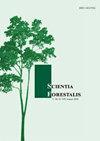Relationship between woody vegetation and edaphic variables in natural forest formations of Paraguay
IF 0.4
4区 农林科学
Q4 FORESTRY
引用次数: 0
Abstract
Correlating vegetation data with environmental variables enables results that allow making inferences about the biological components present in these communities and thus contributing to their recovery. In this context, the objective of this study was to evaluate whether there is a correlation between soil variables, to determine whether these variables influence woody vegetation and which variables best explain this relationship. The study was carried out based on data obtained from the National Forest Inventory of Paraguay in 2015 in 5 forest strata: Dry Forest of the Chaco (BSCH), Sub-humid Flooded Forest of the Paraguay River (BSHIRP), Palmar Forest (BP), Sub-humid Forest of the Cerrado (BSHC) and Humid Forest of the Eastern Region (BHRO), totaling 36 ha sampled. Physical and chemical parameters of the soil and data of total height and diameter at 1.30 m in height (d 1.30 ) of all living shrub-arboreal individuals with d 1.30 ≥ 5 cm were used. For the sampled forest strata, the different soil variables influence the presence of the sampled species. Among soil variables, a strong positive correlation was observed between organic material and organic carbon, as well as silt and clay. In the BSCH, BSHC and BHRO strata, it was possible to attribute relationships between species and edaphic variables, where the edaphic variables that best explained these relationships were clay, sand, silt, organic material and organic carbon. indivíduos arbustivo-arbóreos vivos d 1,30 ≥ 5 cm. Para os as variáveis do solo influenciaram espécies. as correlação material orgânico carbono orgânico, além BSCH, BSHC espécies edáficas que explicaram melhor essas relações foram argila, areia, silte, material orgânico e carbono orgânico. Palavras-chave: Estratos florestais; Análise multivariada; Inventário Florestal Nacional do Paraguai.巴拉圭天然林形成中木本植被与土壤变量的关系
将植被数据与环境变量相关联,可以得出关于这些群落中存在的生物成分的推断结果,从而有助于它们的恢复。在此背景下,本研究的目的是评估土壤变量之间是否存在相关性,确定这些变量是否影响木本植被,以及哪些变量最能解释这种关系。基于2015年巴拉圭国家森林清查数据,对查科干林(BSCH)、巴拉圭河半湿润淹水林(BSHIRP)、棕榈林(BP)、塞拉多半湿润林(BSHC)和东部湿润林(BHRO) 5个森林层进行了36公顷的采样研究。利用土壤理化参数和海拔1.30≥5 cm的所有灌木乔木活个体在1.30 m (d 1.30)处的总高度和直径数据。对于采样森林地层,不同的土壤变量影响采样物种的存在。在土壤变量中,有机质与有机碳、粉土与粘土呈显著正相关。在BSCH、BSHC和BHRO地层中,物种与土壤变量之间的关系是可能的,其中最能解释这些关系的土壤变量是粘土、砂、粉土、有机质和有机碳。Indivíduos arbustivo-arbóreos活体d 1,30≥5 cm。Para os as variáveis do solo influciaram espacacia。as correla 材料orgnico carbono org nico, al BSCH, BSHC espacencyas edáficas que explicaram melhor essas relações foram argila, area, silte,材料organnico e carbono org nico。palavras - have: eststratos florestais;注意multivariada;Inventário巴拉圭国家花卉节
本文章由计算机程序翻译,如有差异,请以英文原文为准。
求助全文
约1分钟内获得全文
求助全文
来源期刊

Scientia Forestalis
Agricultural and Biological Sciences-Forestry
CiteScore
1.00
自引率
0.00%
发文量
39
期刊介绍:
Scientia Forestalis is a scientific publication of the IPEF – Institute of Forest Research and Studies, founded in 1968, as a nonprofit institution, in agreement with the LCF – Department of Forest Sciences of the ESALQ – Luiz de Queiroz College of Agriculture of the USP – São Paulo University. Scientia Forestalis, affiliated to the ABEC – Brazilian Association of Scientific Publishers, publishes four issues per year of original papers related to the several fields of the Forest Sciences.
The Editorial Board is composed by the Editor, the Scientific Editors (evaluating the manuscript), and the Associated Editors (helping on the decision of acceptation or not of the manuscript, analyzed by the Peer-Reviewers.
 求助内容:
求助内容: 应助结果提醒方式:
应助结果提醒方式:


